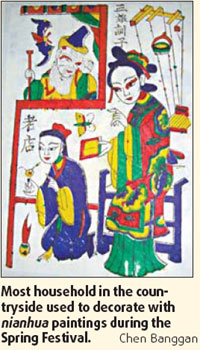Writing's on the wall for New Year paintings
Chinese people used to decorate their homes with nianhua (New Year paintings) during the Spring Festival, which are usually placed on the front door to prevent evil spirits and bring good luck to the family.
Woodprint nianhua paintings, one of the most distinctive wood-block art forms in China, are said to have first appeared during the Tang Dynasty (AD 618-907). However, since the art form was not a high-class cultural icon, it was not well-documented in history books of the time.
The skills of carving wood blocks for printing and painting were handed down from masters to disciples over generations.
Such nianhua woodprint paintings are of pure and plain tastes, and more precious, because they are handmade, and based in the lives of China's masses, said Pu Songnian, an expert of woodprint nianhua.
"They also represent the best art of their time, reflecting the vivid life and colorful images in general people's lives," said Pu.
There are several famous bases of New Year pictures across the country - Yangliuqing in Tianjin, Mianzhu in Sichuan Province, Wuqiang in Hebei Province, Zhuxianzhen in Henan Province and Taohuawu in Jiangsu Province.
Of all those, Yangliuqing New Year pictures boast the best-preserved and largest stock of high quality vintage woodblocks and sketches by artisans from centuries ago, according to Wang Shucun, an expert of woodprint nianhua.
Originating from the town of Yangliuqing in a western suburb of Tianjin in the early 17th century, the works were then and still are made through a combination of woodblock printing and hand painting.
From the very beginning, Yangliuqing nianhua art catered to the tastes of different social classes from ordinary farmers, city dwellers, to emperors of the Ming (1368-1644) and Qing (1644-1911) courts.
The richness of sub-genres and varieties of the folk art attracted many ancient intellectuals to participate in the creation of nianhua art by contributing sketches of figures, landscapes, birds and flowers that are more refined than most of those produced by craftsmen of Yangliuqing pictures.
Over the years the traditional folk art has been on the verge of extinction: both the old-aged masters and the art itself are slipping away with time.
The paintings were rejected as a sign of superstition after the founding of New China in 1949, but in the countryside villagers still bought them to decorate their homes to convey their hope for a better and more prosperous life.
"It was in the past two decades with the fast pace of globalization and economic growth that the art began disappearing at a record rate, falling nearly into extinction," said Pu, who had visited most of the nianhua bases in the country.
"Now when I go down to the countryside I find only one or two masters who can create and carve the wood blocks for printing. Old masters are aging and many have already passed away, without finding young people to learn their skills, because of scarce demand for such paintings," Pu said.
China Daily
(China Daily 05/23/2007 page19)














